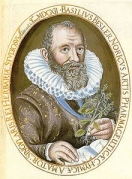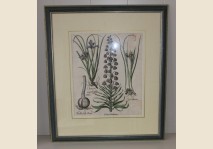Currently Shopping by:
- technic: Etching Remove This Item
Shopping Options
- Specification
-
- Print (1)
- period
-
- 17th century (1)
- School
-
- German (1)
- subject
- rating
-
- *** (1)
- new
-
- no (1)
- Artist
-
- Basilius Bessler (1)
Basil Bessler (1561–1629)
Basilius Besler (1561–1629)
 Respected Nuremberg apothecary and botanist, best known for his monumental Hortus Eystettensis. He was curator of the garden of Johann Konrad von Gemmingen, prince bishop of Eichstätt in Bavaria. The bishop was an enthusiastic botanist who derived great pleasure from his garden, which was the only important European botanical garden outside Italy.
Respected Nuremberg apothecary and botanist, best known for his monumental Hortus Eystettensis. He was curator of the garden of Johann Konrad von Gemmingen, prince bishop of Eichstätt in Bavaria. The bishop was an enthusiastic botanist who derived great pleasure from his garden, which was the only important European botanical garden outside Italy.
These gardens had been started in 1596 and designed by Besler's colleague, Joachim Camerarius the Younger (1534–1598). Upon Camerarius' death in 1598, Besler had the remainder of Camerarius' plants moved to Eichstätt and carried on the work of planting and supervision. The bishop commissioned Besler to compile a codex of the plants growing in his garden, a task which Besler took sixteen years to complet. Besler had the assistance of his brother and a group of skilled German draughtsmen and engravers, including Sebastian Schedel, an accomplished painter, and Wolfgang Kilian, a skilled engraver from Augsburg. Kilian and his team engraved the initial copper plates, but after the bishop’s death, the operations moved to Nürnberg and a new team of engravers, among whom were Johannes Leypold, Georg Gärtner, Levin and Friedrich van Hulsen, Peter Isselburg, Heinrich Ulrich, Dominicus Custos and Servatius Raeven.
The work was named Hortus Eystettensis (Garden at Eichstätt). The emphasis in botanicals of previous centuries had been on medicinal and culinary herbs, and these had usually been depicted in a crude manner. The Hortus Eystettensis changed botanical art overnight. The plates were of garden flowers, herbs and vegetables, exotic plants such as castor-oil and arum lilies. These were depicted near life-size, producing rich detail. The layout was artistically pleasing and quite modern in concept, with the hand-colouring adding greatly to the final effect. The work was first published in 1613 and consisted of 367 copper engravings, with an average of three plants per page, so that a total of 1084 species were depicted. The first edition printed 300 copies, which took four years to sell. The book was printed on large sheets measuring 57 x 46 cm. Two versions were produced, cheap black and white for use as a reference book, and a luxury version without text, printed on quality paper and lavishly hand-coloured. The luxury version sold for an exorbitant 500 florins, while the plain, uncoloured copies went for 35 florins each. Besler could finally purchase a comfortable home in a fashionable part of Nürnberg at a price of 2 500 florins – five coloured copies' worth of ‘Hortus Eystettensis'.








 Facebook
Facebook Twitter
Twitter Subscribe us
Subscribe us Flickr
Flickr




